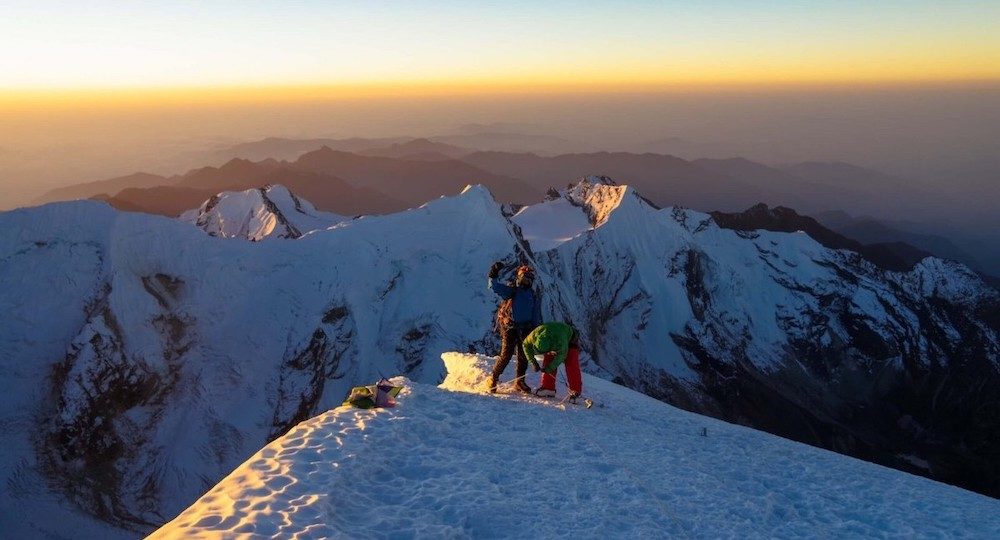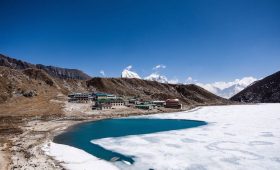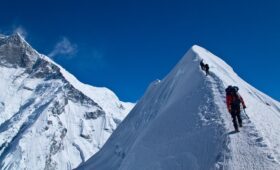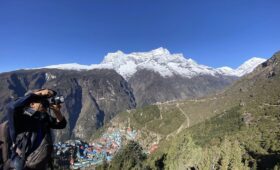Mera Peak is the first choice for many climbers seeking a 6000-meter Himalayan ascent. The summit, which is located in Nepal’s mountainous Everest region, is a big draw for aspiring climbers looking for a non-technical mountain.
Climbers usually make their trip in the spring or autumn, as these two seasons are considered as the best time to climb Mera Peak. Weather conditions remain stable and ideal for climbing Mera Peak during these seasons.
Where is Mera Peak Located?
Mera Peak is located in the spectacular Makalu Barun National Park in eastern Nepal’s Hinku Valley. Mera Peak is Nepal’s highest trekking peak, rising to a height of 6476 meters.
Three Summits Routes of Mera Peak
Mera Peak has three summits: South, Central and North. Most expedition groups pick the Mera Central route for their summit push as it is the most straightforward approach. In 1953, Jimmy Roberts and Sen Tenzing were the first two climbers to reach the summit of Mera Peak (central).
How to Reach Mera Peak?
There are two trekking routes that lead to Khare at the base of Mera Peak. The shortest trail begins in Lukla and continues via Chutanga and the Zatarwa La pass.
The journey to the base of Mera Peak takes only five days, but it is hard. There are long days of trekking over steep and rocky terrain, as well as many crossings over high mountain passes.
The longer and slightly easier route leads through Paiya and Panggom. If you choose this route, it will take you about seven days to trek from Lukla to Mera Peak Base Camp.
Some climbers prefer to travel the traditional route from Jiri or Salleri rather than flying directly to Lukla. Fly to Phaplu and then to Khare via Pangkongma and Nanjing Dingma.
Mera Peak Climbing Route
The climb to Mera Peak is basically non-technical. The first phase of the climb involves climbing through gravel and boulders. It’s a steep climb up to Mera High Camp via Mera La glacier. You stay at High Camp for a night. Your summit push begins early the next morning, at 1 or 2 a.m.
The route ascends the mountain on a gentle gradient of thirty or forty degrees. The final ascent to the summit is the most challenging. The dome of Mera Peak Central’s summit is a hard ascent requiring fixed ropes and jumars.
From the summit, you can see fantastic views of five of the tallest mountains in the world – Mount Everest, Lhotse, Pumori Makalu, Cho Oyu and Kanchenjunga. Apart from these giants, there are several 6000 and 7000-meter peaks stretching as far as the eye can see.
What to expect in the Autumn (September to November)?
Most climbers make their summit attempt on Mera Peak in October. Autumn is by far the most popular and best time to climb Mera Peak. It is drier than the other seasons, and the weather is stable. The skies remain clear, offering breathtaking views of the Himalayas.
However, if you don’t book in advance, you may have to share accommodation with other tourists and might face some difficulties finding lodging.
What to expect in the Spring (March to May)?
After autumn, spring is the best time to climb Mera Peak. Spring has many similarities to autumn. If you plan a spring trip to Mera Peak, you can expect stable and good weather. It is warm during the day, but it is usually cold at night.
Since spring is high season, the trail may be crowded, and getting flight tickets and accommodations might be difficult if you don’t pre-book your trip.
What to expect in the Summer/Monsoon (June to August)?
Climbers and trekkers avoid the trail during the summer and monsoon seasons because it becomes slippery and muddy. There is heavy rainfall, and the trail gets choked by mud and seasonal streams. Throughout the day, fog and mist roll in, obstructing the views.
What to expect in the winter (December to February)?
During winter, extreme cold and snow make it almost impossible to get to Mera Peak and it’s not the best time to climb Mera Peak. The days are shorter, and it gets dark earlier, making it unsafe to spend long hours on the trail. Walking on snow and ice makes a winter journey to Mera Peak challenging.
Permits required for Mera Peak Climbing
You need to get a Mera Peak Climbing permit from the Nepal Mountaineering Association in Kathmandu. The trek requires entrance tickets to the Makalu Barun National Park and the Khumbu Pasang Lhamu Rural Municipality.
Mera Peak Climbing Itinerary
There are basically three itineraries you can use to climb Mera Peak. The Pangom, Paiya, Ningsow, and Chetra Khola route (Mera Peak Climbing) takes about 18 or 20 days to complete.
The shortest and most difficult route takes you to Mera Peak via Chutanga and Kothe. You can complete your trip in 12 or 14 days if you follow this Mera Peak climbing itinerary.
The third option is to fly to Phaplu instead of Lukla. To reach the mountain’s base, you hike through Thaksindo, Cholem Kharka, and Paanch Pokhari. This itinerary will last 19 or 21 days.
Mera Peak climb can be combined with Amphu Labtsa and Everest Base Camp trek for a more exciting journey. Climbers on a Mount Everest expedition sometimes scale both Island peak and Mera Peak to acclimatize.
Can I Climb Mera Peak?
Yes, if you have basic climbing skills and have done a few high-altitude climbs. Mera Peak does not require technical climbing skills, making it the ideal alternative for beginner climbers.
The only thing to be concerned about is the risk of AMS (acute mountain sickness), cold, and high winds. More than climbing skills, reaching the summit of this mountain requires stamina and a high level of endurance.
Mera Peak Climbing Difficulty
Mera Peak is classified as PD (peu difficile, or a bit difficult) on the Alpine grading scale. You will have to ascend at high altitudes, cross glaciers, and walk on ice and snow. Only the final part of the climb is challenging.
The steep ascent to the top will be done with fixed ropes and jumars. You only spend one night at Mera Peak (High Camp) on your way to the summit.
Mera Peak Climbing Gear
The success of any serious peak climbing expedition is depends on planning as well as the quality of gear and equipment. The conditions at high altitudes are extreme and brutal. You must be prepared to handle the extreme mountain environment (cold, wind, snow, and precipitation).
What Makes Mera Peak Unique?
Apart from being Nepal’s tallest trekking peak with a non-technical ascent, Mera Peak is one of the greatest trekking destinations to discover high-altitude Himalayan panorama. The trail to Mera Peak passes through the sparsely populated Hinku and Hongku Valleys.
You may explore one of Nepal’s least visited trails by walking through sub-alpine and alpine areas. You enter the magnificent Makalu Barun National Park, a haven for endangered wildlife and vegetation.
You will be trekking in the wilderness, with no major settlements along the way, staying overnight at guest houses built near yak Kharkas or yak herders’ camps.
Final Say,
Mera Peak is the ideal choice for beginner. The conditions on the mountain prepare you for your next big ascent, which could be more complex and challenging.
This high-altitude climbing is ideal for experienced climbers as an acclimatization climb.
It is important to choose the best time to climb Mera Peak before making plans for your trip. Autumn and spring are by far the best seasons for any peak climbing trip. Planning your expedition during these seasons will surely guarantee a successful summit attempt.
Do you have any question about trip to Nepal?
Tell us about your trip to Nepal and what you expect from it. We will answer your questions in 24 hours and help you design a trip with a comfortable itinerary to best meet your needs.





